A People’s Journey, A Nation’s Story: The Reviews
The long-awaited opening of the Smithsonian’s National Museum of African American History and Culture generated worldwide attention. We’ve gathered some of the most interesting, compelling and thought-provoking reviews of the new museum.
Review: The Smithsonian African American Museum Is Here at Last. And It Uplifts and Upsets.
The New York Times, Sept. 15, 2016
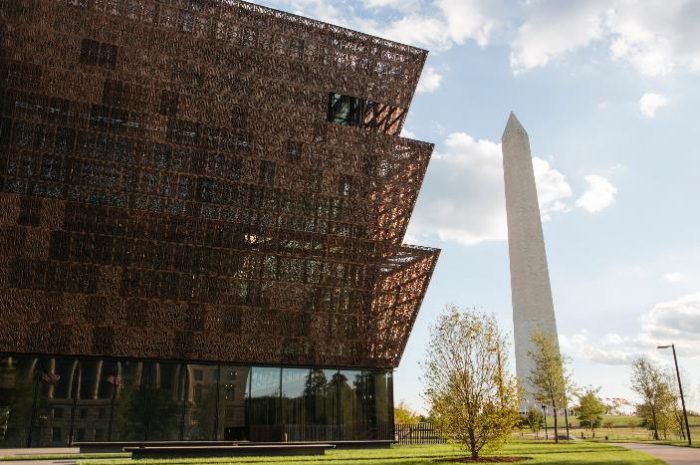
The National Museum of African American History and Culture sits on five acres on the National Mall, close to the Washington Monument. (Photo by Lexey Swall for The New York Times)
On a late summer day in 1963, 200,000 Americans made the Washington Monument the compass needle for a new direction in history, up and forward, when they gathered at its base, then marched a mile or so on to hear the Rev. Dr. Martin Luther King Jr. preach — sing, really — a sermon on racism and a dream of change.
On an early autumn day this Saturday, just yards from the monument, the compass itself will, symbolically speaking, become fully visible, when the National Museum of African American History and Culture opens to the public. To paraphrase the preacher: It’s here at last, here at last. And it’s more than just impressive. It’s a data-packed, engrossing, mood-swinging must-see. Read more from Holland Cotter for The New York Times.
National Museum of African American History and Culture Review: A Moving but Flawed Accounting of History
The Wall Street Journal, Sept. 15, 2016

Jim Crow-era railway car. (Photo by Smithsonian National Museum of African American History and Culture)
In 2005, when Lonnie Bunch was appointed founding director of the National Museum of African American History and Culture, there was no building, no site, no collection and no money. Now, there is a $540 million museum (that figure including money for an endowment) scheduled to open on Sept. 24, so filled with detail and narrative that even a full day’s visit is insufficient for a careful survey. That alone is an imposing achievement. And if the 12 exhibitions that now make up the museum are not all overwhelming, there is so much here-and so much to think about-that the experience still leaves an indelible mark. Read more from Edward Rothstein for The Wall Street Journal (pdf).
The National Museum of African American History and Culture Is Gorgeous But Reductive
New York Magazine, Sept. 16, 2016
…Architecture and identity rarely fuse as convincingly as they do here. Simple in form and intricate in execution, the museum performs an impossible job with grace, walking visitors through a linear tale and at the same time submerging them in the crosscurrents of black America. It educates and confuses, exalts and enrages, simplifies history and pummels visitors with hailstones of knowledge. At times a visit feels like wandering through a sprawling bibliography; each vitrine makes me want to read another book. Read more from Justin Davidson for New York Magazine.
The challenge of presenting ‘African American music’: First, define it.
The Washington Post, Sept. 21, 2016
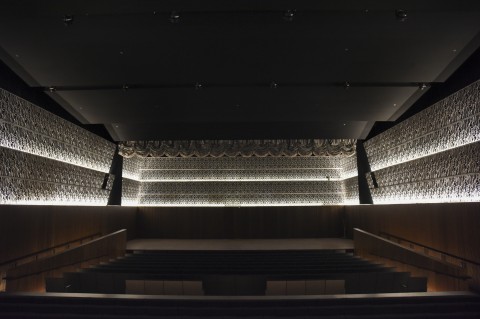
The 350-seat theater in the National Museum of African American history and Cultureis named after Oprah Winfrey, who donated at least $13 million toward the construction of the museum. (Jahi Chikwendiu / The Washington Post)
I often hear that music is like a museum. This is meant as a criticism, implying that it is devoted to displaying old things in a relatively static way. Music, though, should be so lucky, since museums today are dynamic, interactive, varied, state-of-the-art temples to understanding more about our art, our world, our history and our lives. If you doubt this, take a look at the excitement surrounding the opening of the National Museum of African American History and Culture this weekend. And rather than criticizing music for its supposedly muséal qualities, we should examine how museums can present music. Read more from Anne Midgette for The Washington Post.
Can a thorough, thoughtful museum speak to a new racist age?
The Washington Post, Sept. 21, 2016
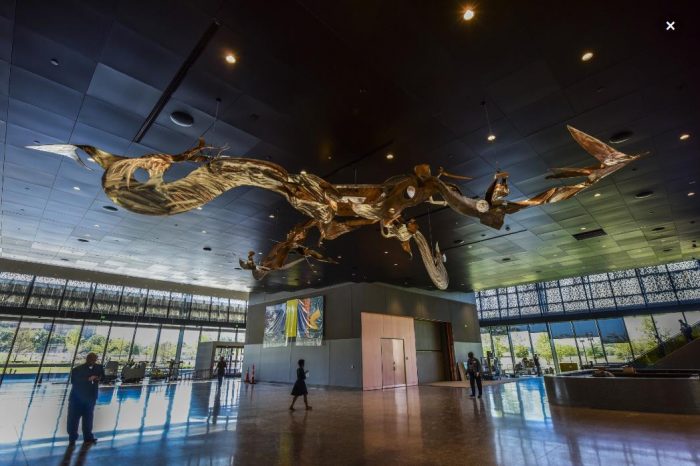
A sculpture by African American abstract artist Richard Hunt welcomes visitors in the museum’s lobby. (Photo by Jahi Chikwendiu / The Washington Post)
In the excitement over the opening of the new Smithsonian National Museum of African American History and Culture, it’s easy to forget that for a long time, in many quarters, the word “museum” has been a bit suspect. To say that something “belongs in a museum” is another way of saying that it belongs to a forgotten or dead past, or has become irrelevant. For much of the 20th century, museums were criticized as vestigial remnants of colonialism, patriarchy, elitism and what we now call “white privilege.” Read more from Philip Kennicott for The Washington Post.
Critic’s Notebook: On Day Two, a new establishment museum begins its work
The Washington Post, Sept. 26, 2016
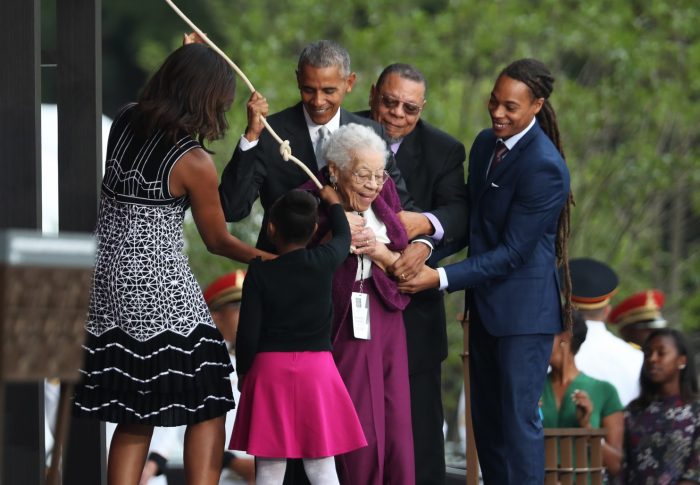
President Obama, first lady Michelle Obama and Ruth Odom Bonner, center, ring the bell opening the Smithsonian National Museum of African American History and Culture on Saturday. (Manuel Balce Ceneta/Associated Press)
After 99-year-old Ruth Odom Bonner, whose father was born into slavery, helped ring the bell that opened the National Museum of African American History and Culture on Saturday, it was hard to be in a sea of people. On the Mall, only a few blocks from the museum, they were playing Frisbee. A dog scampered between two people who seemed to know each other. America was in shorts and flip-flops, grazing from food trucks, lolling on the lawn, taking selfies. Something solemn, momentous, perhaps even transformative had just happened, and the president of the United States had spoken some of the simplest but most powerful words of his presidency: “We’re not a burden on America, or a stain on America, or an object of pity or charity for America. We’re America.” Read more from Philip Kennicott for The Washington Post.
Beautiful, Stirring, and Overcrowded
Slate, Oct. 4, 2016
The many small successes, and one large failure, of the Smithsonian’s National Museum of African American History and Culture. Read more from Dan Kois for Slate.
Justice Thomas’ story deserves more in-depth telling at African-American museum
The Chicago Tribune, Oct. 10, 2016
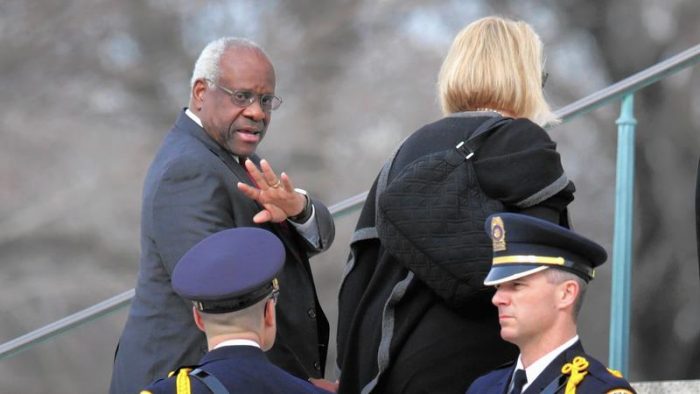
Supreme Court Justice Clarence Thomas and his wife, Virginia Thomas, attend Justice Antonin Scalia’s funeral in February, (Chip Somodevilla / Getty)
By most social standards, U.S. Supreme Court Justice Clarence Thomas would be considered a model African-American.
Born into poverty in the rural South, Thomas worked his way to judicial heights that only one other African-American — Thurgood Marshall — has reached. He could have been a champion for the rights of other African-Americans to reach their greatest potential. But he has chosen not to carry that torch. Read more from Dahleen Glanton for The Chicago Tribune.
Posted: 21 October 2016





